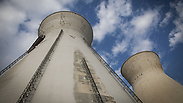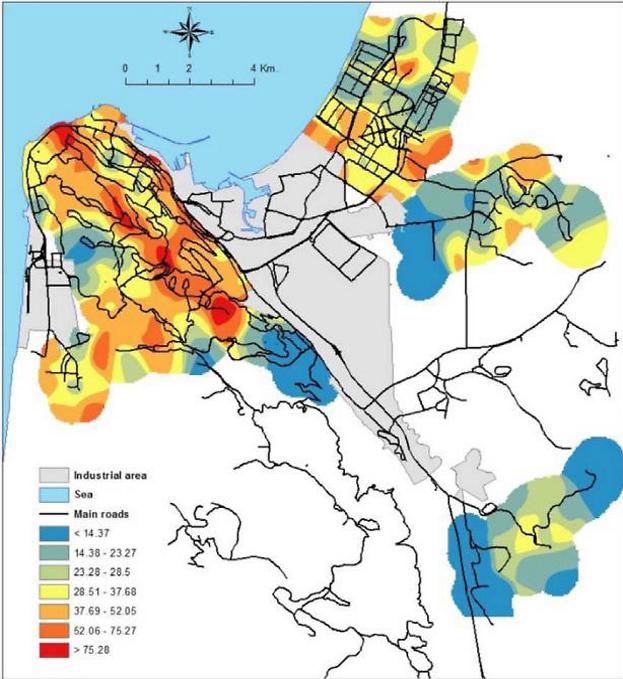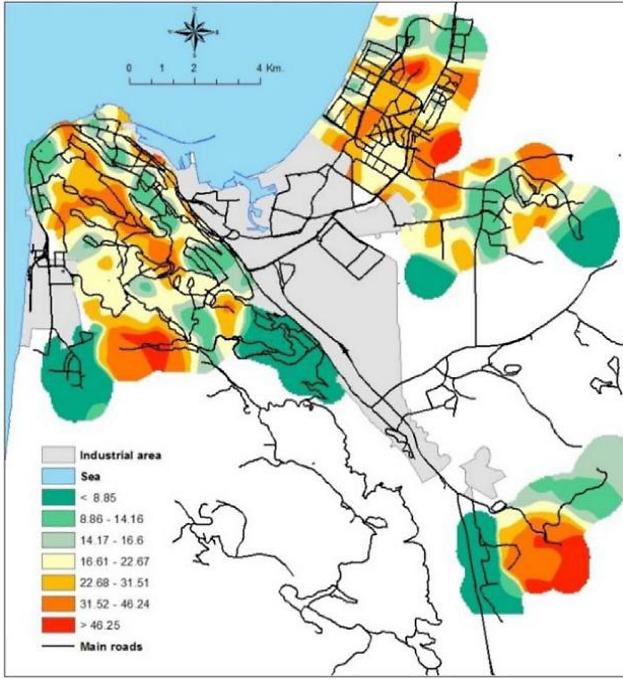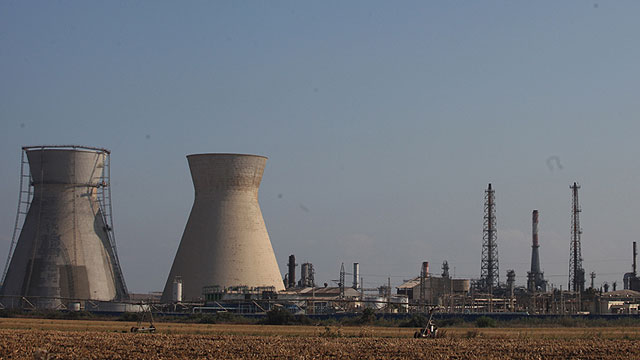
Refineries in Haifa
צילום: אבישג שאר-ישוב
New study points to Haifa area cancer 'hot spots' caused by pollution
Maps show higher than average morbidity rates in areas in close vicinity of petrochemical industry in the city, including high lung cancer rates in some areas of Kiryat Haim and Kiryat Ata, and higher than average rates of non-hodgkin lymphoma in Kiryat Tiv'on and Kiryat Bialik.
A new study has examined the connection between air pollution in the Haifa District and the rates of cancer in the area, finding morbidity rates higher than the national average in areas located closer to the petrochemical factories in the city.


The Israeli researchers published maps in the prestigious Environmental Research journal showing which areas of Haifa and its surroundings have the highest rates of lung cancer and non-hodgkin lymphoma—two types of cancer linked to air pollution.
In recent years, Israel's Health Ministry determined that there is a connection between the morbidity rates in the Haifa District and the air pollution in the area, which is caused by the petrochemical factories located in the heart of the bay, among other factors. The Environmental Protection Ministry, meanwhile, stressed that air pollution caused by vehicles also plays a major role in the emission of dangerous pollutants in the area.
But while the two ministries agreed that the level of air pollution in the area was extreme, experts disagreed on whether it posed a concrete risk to the residents' health; if so, in what way; and which areas were the hot spots.
Several months ago, researchers from the Haifa University released the conclusions of a study they conducted, in which they argued that air pollution was responsible for the high levels of morbidity in the area. One of the findings in their study, which caused much controversy, was that babies born in Haifa and the surrounding areas were born with smaller heads.
The Health Ministry rejected the study and published data that supposedly contradicted it.
After a joint committee of the Health and Environmental Protective Ministries examined the results of the study, the Environmental Protection Ministry announced the research methods used posed some problems. The ministry also announced its plans to publish the study in full alongside a report on the quality of the study. Environmental organizations, meanwhile, claimed the ministry was trying to cover up the study and change its conclusions.

Lung-cancer rates in the Haifa District, with red, orange and yellow areas having above-average rates.
The new study in Environmental Research presents different research methods that seek to neutralize other influencing factors, such as one's financial situation, social status, state of employment, whether or not one smokes, etc. on morbidity rates to produce data that could clearly point to the nature of the connection between cancer rates and air pollution.
The maps show which areas in the Haifa District have cancer rates higher than the national average, and which are below the national average. The maps show "hot spots" of morbidity on Mount Carmel and its slopes, near the Haifa Port, where the Haifa power station is located, and the city of Nesher.
There are also higher than average rates of lung cancer—though not in the highest levels—in some areas of the Kiryat Haim suburb and the city of Kiryat Ata. "Hot spots" of non-hodgkin lymphoma were found in the town of Kiryat Tiv'on and the city of Kiryat Bialik.

Non-hodgkin lymphoma rates in the Haifa District, with red, orange and yellow indicating above-average rates.
The data used in the new study is based on data from the Israeli Cancer Register.
Among other things, the maps show that areas facing the industrial areas, the refineries, the petrochemical industry and the power station all had a relatively high amount of cancer diagnoses—which supposedly supports the claim that the industry has an influence on the morbidity rates.
The Health Ministry will have a hard time rejecting this study, as among the researchers is Prof. Lital Keinan Boker, the deputy director of the Israel Center of Disease Control (ICDC) that is responsible, among other things, to managing the national Cancer Register.
The Environmental Protection Ministry claims that the actions it has been performing in recent years have led to a significant reduction in the volume of pollutants released by industrial plants in the Haifa bay area, and that new restrictions it placed on the refineries in the area should lead to an additional reduction. However, ministry officials have only recently admitted that the rate of air pollution caused by transportation, which is responsible to a significant portion of health risks, is not about to change.
Environmental activists in the Haifa area are even more pessimistic, claiming the demands the ministry set to the refineries are not enough. They say some of these restrictions would not lead to a reduction in the emission of pollutants at all, and those that could are years from being put into practice, if at all.











